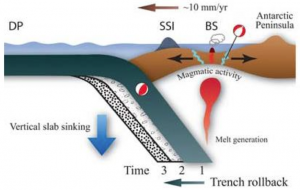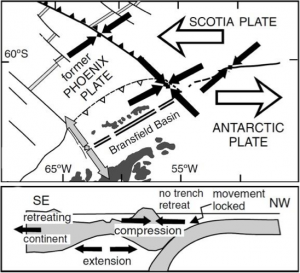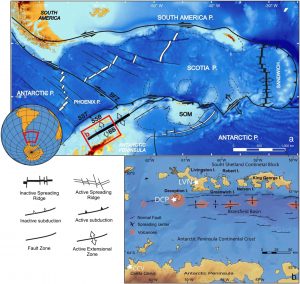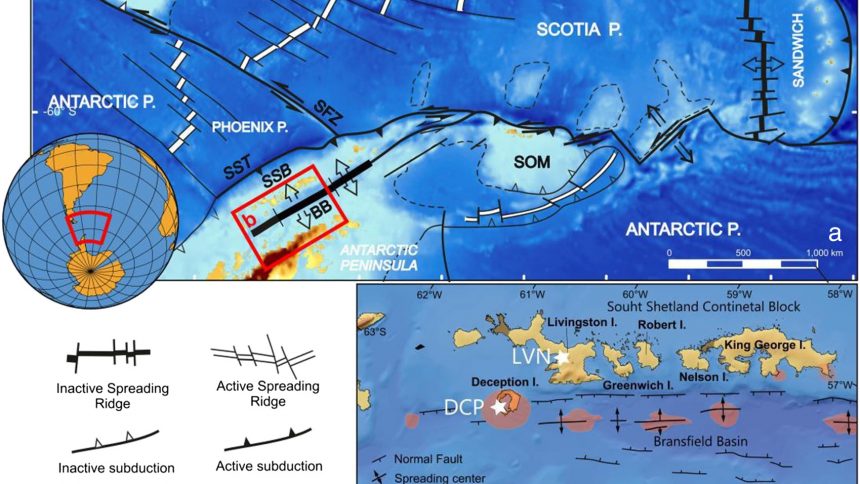Plate tectonics is a theory intended to explain the movements of the structures in which the Earth’s crust is divided. The comprehension of this theory is essential to be able to know how our planet works. The knowledge about the Earth would allow us to understand other rocky planets in a more accurate way. The dynamics of these structures lead us to study phenomena such as the volcanic activity, how and why it happens.
The BRAVOSEIS (BRAnsfield VOlcano SEISmology) project has been proposed to shed light on seismic activity at Central Bransfield Basin in Bransfield Strait.
In this region we can find a convergence among five tectonic plates. The two principal plates are South-America and Antarctica Plate, the other three plates are Scotia, Phoenix and South Shetland microplates. This geological disposition make this location one the most interesting places on Earth in a geodynamical sense.
Mainly, there are two theories to explain what it is going on at Bransfield Strait among the interacting tectonic plates. On one hand , we have the theory that suggests that the Phoenix plate is subducting under the South Shetland plate. On the other hand, the Bransfield Strait might be opening as a zipper does, as a response to shear motions.

Figure (1): Northwest – Southeast section at Drake Passage to Antarctic Peninsula. Subduction of Phoenix microplate under South Shetland microplate [3].
The other possible explanation comes from the movements that could be observed between Scotia microplate and Antarctic plate. A movement in opposed directions of both plates generates a shear stress between them. The collision between Scotia microplate and Antarctic plate would be pushing the Phoenix microplate at northwest direction. In this case that South Shetland Trench would not be in movement, as it can be inferred by the lack of seismic activity near the trench. The South Shetland block could be suffering a compression in northwest – southeast direction Figure (2). This could be generating stresses at this region, forcing the South Shetland microplate to go apart from Antarctic plate [7]. This kind of shear is doing the Bransfield Strait to open in an extensional phenomena like a zipper.

Figure (2): Tectonic scheme in northwest-southeast direction at Bransfield Strait region. In this map, the shear stress of all plates and microplates are marked and it is possible to see how the rift is opening as a consequence of stress generated by shear movements [7].
The Central Basin has suffered most of continental extensional processes generated at this region. The studies about the Mohorovičić discontinuity, show that the crust is thinner at basin’s regions that are in a nearer position to Antarctica Peninsula in northwest direction. It also has been observed that, Moho depth grows in southwest direction. This demonstrates that crust is also thinner toward the South Shetland Islands.
In a perpendicular direction to the extension, parallel to Bransfield Strait direction, volcanic processes can be found. Nevertheless, these volcanoes are not in the same line, what avoid the possible affirmation that the rift has a common and unique origin.
Some of the South Shetland Islands have active volcanoes with recent activity, for example, Bridgeman and Penguin islands NE of the Central basin, and Deception island to the SW. Beside the emerged volcanoes, recent studies have found several structures in the Central basin with a possible volcanic origin, we would be speaking about submarine volcanoes.
However, the scarcity of seismic stations makes it hard to detect the seismo-volcanic low magnitude activity. The detected seismicity is mostly related to the extension processes in the region. Nevertheless, some studies [3] has been able to detect seismicity that seems to have a volcanic origin not associated directly to extensional process.

Figure (3): a. Scotia microplate map in which we can see the most important microplate boundaries for the study of the Bransfield strait. It is marked that at South Shetland Trench (SST) Phoenix microplate is subducing under the South Shetland Block (SSB) [1].
